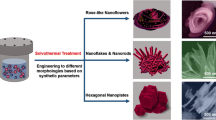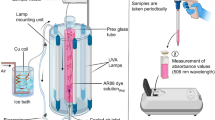Abstract
Different ZnS nanostructures synthesized by a chemical solution process were deposited on the glass substrate by dip coating technique. The effect of the sol-pH variation on the surface morphology, crystalline quality, optical band gap, and photoluminescence of the ZnS nanosphere, nanorod and mixed hexagonal cubic and rectangular-like nano-grains were investigated. It was found that the triethanolamine/ethanolamine played a key role to get desired nanostructure quality with different surface morphology. All nanostructures, derived in acidic and basic medium showed mixed cubic and hexagonal crystalline structure with preferred orientation along (111) plane of predominant cubic phase without oxidation. Nanospherical grains, sharply increased in size observed in acidic medium, whereas nanorods and mixed hexagonal, cubic and rectangular-like grains, slightly increased and then decreased in size, observed in basic medium with increased pH. The increased/decreased in average crystallite size was confirmed by reduced/enhanced dislocation density and micro strain. Comparatively, the band gap (Eg) of the nano-grains, reduced by pH derived in acidic medium was higher than those derived in basic medium. Comparatively, the higher surface defects related emission was observed in nanostructures derived in acidic medium than those derived in basic medium, whereas a higher green emission was observed in nanostructures fabricated at basic medium compared with the nanostructures synthesized in acidic medium. The results showed better crystalline quality in nano-grains derived at acidic medium than those derived at basic medium, whereas better optical quality in nanostructures derived at basic medium compared with the nanostructures derived at acidic medium. The observed characteristics are highly attractive for solar cells and optoelectronic applications.

To get ZnS solution by chemical route, using glacial acetic (solvent) acid with triethanolamine (pH regulator) leads to the spherical ZnS nano-grains at any pH value, whereas using 2-methoxyethanol (solvent) with ethanolamine (pH regulator) brings about nanorods, undefined and mixed hexagonal, cubic and rectangular ZnS nano-grains at pH 8.0, 9.0, and 10.04, respectively.
Highlights
-
Growth of chemically deposited different ZnS nanostructures.
-
Formation of ZnS nanorods without using any capping agent at pH 8.0.
-
A higher crystalline quality in ZnS nanostructures derived in acidic medium than the others.
-
Comparatively a better optical quality in the ZnS nanostructures derived in basic medium than the others.
-
Enhancement of the optical constants of the ZnS nanostructures as growthing medium shifted from acidic to basic.









Similar content being viewed by others
References
Zhu Y-P, Li J, Ma T-Y, Liu Y-P, Du G, Yuan Z-Y (2014) Sonochemistry-assisted synthesis and optical properties of mesoporous ZnS nanomaterials. J Mater Chem A2:1093–1101
Datta S, Kabir M, Saha-Dasgupta T (2012) Effects of shape and composition on the properties of CdS nanocrystals. Phys Rev B 86:115307
Fang X, Wu L, Hu L (2011) ZnS nanostructure arrays: a developing material star. Adv Mater 23:585–598
Fang X, Zhai T, Gautam UK, Li L, Wu L, Bando Y, Golberg D (2011) Recent advances in zinc sulfıde nanostructures. Prog Mater Sci 56:175–287
Ziegler J, Shu X, Kucur E, Meister F, Batentschuk M, Gindele F, Nann T (2008) Silica‐coated InP/ZnS nanocrystals as converter material in white LEDs. Adv Mater 20:4068–4073
Liu X, Cai X, Mao J, Jin C, Liu X, Cai X, Mao J, Jin C (2001) ZnS/Ag/ZnS nano-multilayer films for transparent electrodes in flat display application. Appl Surf Sci 183:103–110
Velumani S, Ascencio JA (2003) Characterization of ZincPhthalocynanine (ZnPc) for photovoltaic applications. Appl Phys A Mater Sci Process 72:236–247
Luo P-F, Jiang G-S, Zhu C-F (2009) Pulsed laser deposition ZnS buffer layers for CIGS solar cells chin. J Chem Phys 22:97–101
Sookhakian M, Amin YM, Basirun WJ, Tajabadi MT, Kamarulzaman N (2014) Synthesis, structural, and optical properties of type-II ZnO-ZnS core-shell nanostructure. J Lumin 145:244–252
Goktas A (2015) Sol-gel derived Zn1-xFexS diluted magnetic semiconductor thin films: compositional dependent room or above room temperature ferromagnetism. Appl Surf Sci 340:151–159
Nakada T, Mizutani M, Hagiwara Y, Kunioka A (2001) Improvement of CIGS thin-film solar cell performance by optimization of Zn(O,S) buffer layer parameters. Sol Energy Mater Sol Cells 67:255–260
Hichou AEl, Addou M, Bubendorff JL, Ebothe J, Idrissi BEl, Troyon M (2004) Microstructure and cathodoluminescence study of sprayed Al and Sn doped ZnS thin films. Semicon Sci Technol 19:230–235
Liu Q, Guobing M, Jianping A (2008) Chemical bath-deposited ZnS thin films: preparation and characterization. Appl Surf Sci 254:5711–5714
Shao LX, Chang KH, Hwang HL (2003) Zinc sulfide thin films deposited by RF reactive sputtering for photovoltaic applications. Appl Surf Sci 212–213:305–310
Mane RS, Lokhande CD (2000) Chemical deposition method for metal chalcogenide thin films. Mater Chem Phys 65:1–31
Charinpanitkul T, Chanagul A, Dutta J, Rungsardthong U, Tanthapanichakoon W (2005) Effects of cosurfactant on ZnS nanoparticle synthesis in microemulsion. Sci Technol Adv Mater 6:266–271
Rahdar A (2013) Effect of 2-mercaptoethanol as capping agent on ZnS nanoparticles: structural and optical characterization. J Nanostruct Chem 3:10–15
Gao W, Cao M, Xiao W, Lei F, Huang J, Sun Y, Wang L, Shen Y (2016) Effects of reaction conditions on the structural, morphological and optical properties of solvothermal synthesized ZnS nanostructures. Mater Scien Semicon Process 56:349–356
Goktas A, Mutlu İH (2016) Structural, optical, and magnetic properties of solution-processed co-doped ZnS thin films. J Elec Mater 45:5709–5721
Luque PA, Castro-Beltran A, Vilchis-Nestor AR, Quevedo-Lopez MA, Olivas A (2015) Influence of pH on properties of ZnS thin films deposited on SiO2 substrate by chemical bath deposition. Mater Lett 140:148–150
Antony A, Murali KV, Manoj R, Jayaraj MK (2005) The effect of the pH value on the growth and properties of chemical-bath-deposited ZnS thin films. Mater Chem Phys 90:106–110
Ben Nasr T, Kamoun N, Kanzari M M, Bennaceur R (2006) Effect of pH on the properties of ZnS thin films grown by chemical bath deposition. Thin Solid Films 500:4–8
Shayesteh SF, Kolahi S, Kalandarragh YA (2013) Effect of pH on the structural and optical properties of ZnS nanoparticles embeded in PVA matrix. Ind J Pur Appl Phys 51:780–783
Choudapur VH, Bennal AS, Raju AB (2018) Influence of pH on optoelectronic properties of zinc sulphide thin films prepared using hydrothermal and spin coating method. Mater Res Expr 5:045201
Akhtar MS, Riaz S, Naseem S (2015) Optical properties of sol-gel deposited ZnS thin films: spectroscopic ellipsometry. Mater Today Pro 2:5497–5503
Reyes O, Maldonado D, Escorcia-Garcia J, Sebastian PJ (2018) Effect of temperature and pH on direct chemical bath deposition of cuprous oxide thin films. J Mater Sci Mater Electr 29:15535–15545
El Hamidi A, Meziane K, El Hichou A, Jannane T, Liba A, El Haskouri J, Amorós P, Almaggoussi A (2018) Refractive index controlled by film morphology and free carrier density in undoped ZnO through sol-pH variation. Optik 158:1139–1146
Hamad S, Cristol S, Richard C, Catlow A (2002) Surface structures and crystal morphology of ZnS: computational study. J Phys Chem B 106:11002–11008
Aslan F, Tumbul A, Göktaş A, Budakoğlu R, Mutlu İH (2016) Growth of ZnO nanorod arrays by one-step sol–gel process. J Sol-Gel Sci Technol 80:389–395
Hafeez M, Manzoor U, Bhatti AS, Burak Kaynar M, Ismat Shah S (2011) Catalyst solubility and self-doping in ZnS nanostructures. J Appl Phys 110:014317
Goktas A, Aslan F, Yasar E, Mutlu IH (2012) Preparation and characterisation of thickness dependent nano-structured ZnS thin films by sol–gel technique. J Mater Sci Mater Electron 23:1361–1366
Schmidt RL, Kunc K, Cardona M, Bilz H (1979) Second-order Raman scattering in II-VI semiconductors: relative intensities and trends. Phys Rev B 20:3345–3350
Bouznit Y, Beggah Y, Boukerika A, Lahreche A, Ynineb F (2013) New co-spray way to synthesize high quality ZnS films. Appl Surf Sci 284:936–941
Lee HJ, Lee SI (2007) Deposition and optical properties of nanocrystalline ZnS thin films by a chemical method. Curr Appl Phys 7:193–197
Fathy N, Ichimura M (2005) Photoelectrical properties of ZnS thin films deposited from aqueous solution using pulse electrochemical deposition. Sol Energy Mater Sol Cells 87:747–756
Murase N, Jagannathan R, Kanematsu Y, Watanabe M, Kurita A, Hirata H, Yazawa T, Kushida T (1999) Fluorescence and EPR characteristics of Mn2+-doped ZnS nanocrystals prepared by aqueous colloidal method. J Phys Chem B 103:754–760
Acknowledgements
Financial support from the Scientific Research Project Commission of Harran University (HUBAK) under Project No. 18062 is gratefully acknowledged.
Author information
Authors and Affiliations
Corresponding author
Ethics declarations
Conflict of interest
The authors declare that they have no conflict of interest.
Additional information
Publisher’s note: Springer Nature remains neutral with regard to jurisdictional claims in published maps and institutional affiliations.
Rights and permissions
About this article
Cite this article
Goktas, A., Tumbul, A. & Aslan, F. A new approach to growth of chemically depositable different ZnS nanostructures. J Sol-Gel Sci Technol 90, 487–497 (2019). https://doi.org/10.1007/s10971-019-04990-9
Received:
Accepted:
Published:
Issue Date:
DOI: https://doi.org/10.1007/s10971-019-04990-9




